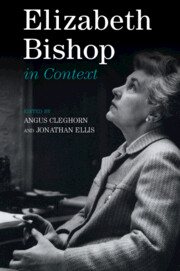Book contents
- Elizabeth Bishop in Context
- Elizabeth Bishop in Context
- Copyright page
- Contents
- Figure
- Contributors
- Acknowledgements
- Note on Referencing and Abbreviations
- Chronology
- Introduction
- Part I Places
- Part II Forms
- Part III Literary Contexts
- Part IV Politics, Society and Culture
- Part V Identity
- Part VI Reception and Criticism
- Works Cited
- Index
Introduction
Published online by Cambridge University Press: 06 August 2021
- Elizabeth Bishop in Context
- Elizabeth Bishop in Context
- Copyright page
- Contents
- Figure
- Contributors
- Acknowledgements
- Note on Referencing and Abbreviations
- Chronology
- Introduction
- Part I Places
- Part II Forms
- Part III Literary Contexts
- Part IV Politics, Society and Culture
- Part V Identity
- Part VI Reception and Criticism
- Works Cited
- Index
Summary
A day later, writing to Robert Lowell, she complained about the students’ poetic influences, in particular the influence of the poet she replaced, Theodore Roethke: “They are so wrapped up in Roethke, still, and he also left an anti-Pound, anti-Eliot heritage, but I go blithely on giving them things they look blasé about – even Tennyson and Keats. The eastern influence! – only here it’s west. One boy gave me 100 haikus – or haikai, as I believe the plural is” (WIA 599). One of Bishop’s students, the artist Wesley Wehr, made notes he later published on what Bishop talked about in the classroom. In her very first class, as if to dispel Roethke’s influence directly, she read Eliot aloud and told them to look up e.e. cummings and the rain poems of Apollinaire. For their first assignment, they were given A. E. Housman to read. “Some of you have very good ears,” she told them. “But your sense of rhyme and form is atrocious.”
- Type
- Chapter
- Information
- Elizabeth Bishop in Context , pp. 1 - 14Publisher: Cambridge University PressPrint publication year: 2021

